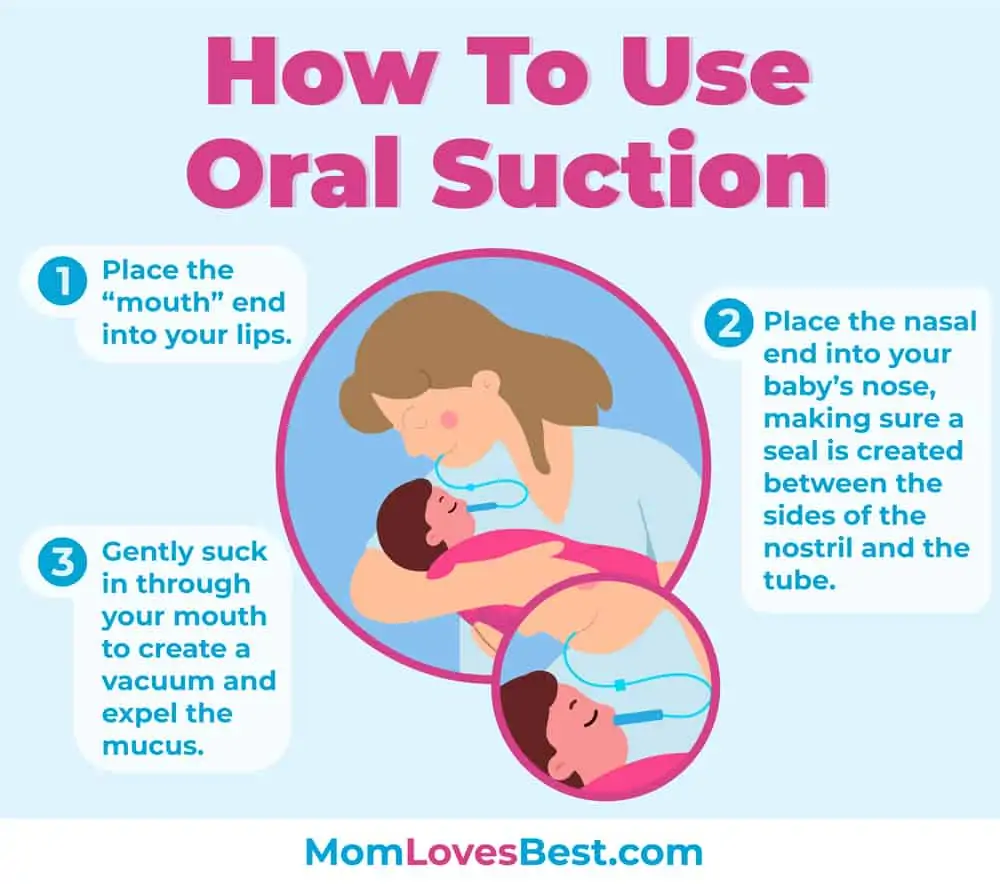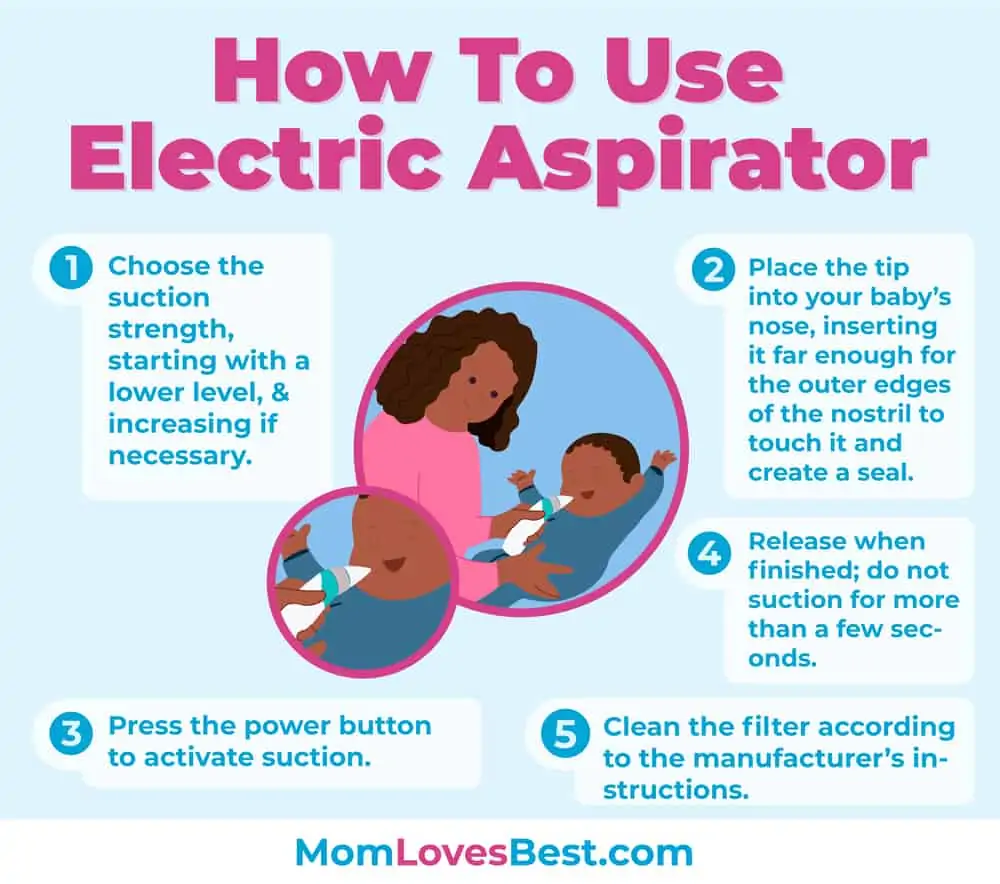Is your baby suffering from nasal congestion? Are you looking for ways you can provide relief?
Watching your baby struggle with their first stuffy nose can be heartbreaking. And they need your help to overcome it since they aren’t old enough to clear their nose out alone.
We’re here to help!
We have suggestions for steps you can take at home to relieve your little one’s discomfort. We’ll also discuss over-the-counter medications and their safety. We’ll explain what causes baby nasal congestion, what the symptoms are, and when you should ditch the home treatment and see a doctor.
Key Takeaways
- Nasal congestion in babies can be caused by various factors such as dry air, nasal infections, allergies, and anatomical blockages.
- Symptoms of nasal congestion in babies include feeding difficulties, trouble sleeping, nasal discharge, and noisy nasal breathing.
- To relieve congestion, try saline drops, a suction bulb or nasal aspirator, using a humidifier, or keeping the baby in an upright position.
- Avoid using Vicks Vaporub, over-the-counter nasal decongestants, and inserting objects into the baby’s nose; always consult a doctor before using any treatments.
What Causes Nasal Congestion in Babies?
Nasal congestion very often occurs when the tissues inside the nose begin to swell. The production of mucus usually accompanies this. There are various things that can cause your baby to develop nasal congestion.
- Little noses: A baby has small nasal passages that it doesn’t take much mucus to block their nose, and you will hear the congestion.
- Cannot blow their nose: Imagine if you were too little to clean out your nose yourself and you couldn’t even blow your nose! All of the secretions would get stuck in there and stay around for a while, at least until you sneeze. It is helpful to know that sneezing is one of the ways infants clear their noses.
- Dry air: Artificial heat and air conditioning can leave the air in your home super dry. This can cause some nasal irritation, resulting in congestion.
- Nasal infection: Infant nasal infections are due to viruses like the common cold. As long as the virus is living and multiplying in that area, the body will respond by producing inflammation, and thick mucus secretions will develop that can block their nose (1).
- Irritants: Your baby has a sensitive nose, and any irritants like dust, cleaning products, perfumes, artificial scents, animal dander, or cigarette smoke can cause issues.
- Trauma: Too much nasal suctioning can cause irritation and the development of mucus and congestion, so keep that in mind. Babies can sometimes manage to get their fingers into their noses, which may cause irritation and even bleeding.
- Foreign objects in the nose: Babies put most things they can reach into their mouths. Sometimes, they can accidentally put objects into their nose, blocking their normal breathing and increasing nasal secretions.
- Reflux: Everyone knows that babies spit up a lot and that it’s normal. Sometimes, it can even come up through their nose, which may be a little startling for moms. The stomach contents and acid irritate the nasal passages and, if this frequently happens, even on a low level where you can’t see it, it can cause ongoing nasal congestion in the back part of the nose.
- Allergies: When allergy season kicks in, the people affected by it know right away. Your baby may be sensitive to the same things you are. Pollens can create havoc inside the nasal passages, and it’s even worse on windy days when the particles sail through the air and into your nose. These effects tend to be seasonal, but other types of allergies, such as those to milk products, can cause ongoing increased mucus production.
- Nasal growths: The growth or enlargement of abnormal nasal tissue is somewhat unusual in babies. It can be from things like nasal polyps (found more often in children with cystic fibrosis), cysts that form due to dilation of the tear ducts, and rare nasal tumors (2).
- Anatomical blockage: Besides having a growth in the nasal passage, babies can be born with a structural problem that blocks the airway. Sometimes the cartilage of the nose isn’t straight, creating a narrowing called stenosis that can stop the air from flowing smoothly. Also, a problem can occur during the development of the nasal structures that causes them to be misshapen, affecting the airflow. An example of this is choanal atresia (3).
What Are The Symptoms?
It is important to know the symptoms associated with nasal congestion so you can determine if that is your baby’s issue. Baby nasal congestion is a fairly obvious problem, but there are some things that go along with it that may not be as apparent.
- Feeding difficulties.
- Trouble sleeping.
- Nasal discharge.
- Noisy nasal breathing.
- Snoring.
- Snorting.
- Sneezing.
- Coughing.
- Spitting up through the nose.
- Baby picking at the nose.
Your baby may experience several of these, but that doesn’t necessarily mean that they are suffering from nasal congestion. The most tell-tale symptoms are nasal discharge and noisy breathing.
It’s common for your baby to have noisy nasal breathing and sneezing in the first few days of life, and it improves over the first week. It is likely that your baby still has some amniotic fluids they are trying to expel.
How To Relieve Nasal Congestion
The moment you notice your baby is a little congested, you probably begin wondering what you can do to help. Depending on the severity of the congestion, you have varied options.
- Saline drops: Administering saline drops into the nose can help thin out the mucus and clear the airways. Once you put the saline drops in and wait a few minutes, you can use a suction bulb or nasal aspirator to suck out the mucus. You can also flip your baby over onto their stomach to let the saline drain out naturally.
Allergens and irritants in the air can land in the nose, sit in there for periods of time, and cause irritation galore. It can be very helpful to use nasal saline to clear them out of the nose, especially before bedtime. - Suction bulb: Insert the end of a suction bulb into your baby’s nose, and squeeze the bulb to suction the snot out. These bulbs are usually given to you in the hospital, but some parents choose to buy a nasal aspirator instead.
- Nasal aspirator: Many moms find that a nasal aspirator is a much more efficient way to remove mucus from your baby’s nose. The NoseFrida is one popular oral suction aspirator on the market.
You can also purchase electric aspirators to do the job. - Humidifier: The use of a cool-mist humidifier will help to keep the air in your baby’s room moist. Moist air serves to keep the air passages from drying out and will even help loosen the built-up mucus in your baby’s nose.
- Vaporizer: A vaporizer is another effective method. Some parents choose vaporizers because they can attach menthol pads to help give their baby additional relief. The warm steam can help loosen your baby’s mucus, but be careful not to get too close because it can cause burns.
- Steam: Steam is a great way to help your baby clear their nose. An excellent way to do this is to go into the bathroom, shut the door, and run the shower for a few minutes, filling the room with steam. Then turn it off. Find a comfortable place for you and your baby to sit in there for about 10 minutes or so, allowing the steam to work its magic.
- Feed more frequently: Your baby may be struggling to eat due to the inability to breathe through the nose properly, but it’s important they still get those feedings. You may find that they want to feed for a short time because it is so much work, so try to offer feeds more frequently. Keeping your baby well-fed and hydrated helps them stay healthy and fight off any illness that might be causing the congestion.
- Wear your baby: You probably know from experience that nothing is worse than having nasal congestion and lying in a flat position. If you wear your baby by using a baby carrier, your baby will be in an upright position, which encourages the mucus to drain.
- Tummy time: Laying your baby on their stomach is another good way to help the secretions flow. Tummy time is helpful for your baby’s development and should be done several times a day anyway until they can sit up. Use a brightly-colored object in front of them to keep their attention, and give them lots of smiles and praise.
- Improve air quality: Instal a filter on your home air conditioner and heater unit to eliminate allergens. Avoid smoking indoors, vacuuming regularly, wearing heavy scents or perfumes, and using scented detergent and body washes. Taking these measures will help improve your home’s air quality and prevent nasal congestion in your baby.
- Steam: Steam is a great way to help your baby clear their nose. Take your baby into the bathroom, shut the door, and run the shower while you remain in the room (but not in the water). Make sure you don’t stay there too long because your baby may become too warm.
- Know when to wait: If the congestion is not bothering your baby, you probably don’t need to intervene quite yet. Watch your baby for signs of illness, such as fever, not feeding enough in a 24-hour period, not urinating as much as usual, having difficulty breathing, or having smelly and concentrated urine.
There are over-the-counter medications designed for nasal congestion, but many of them have dangerous risks associated with them and are not recommended for use until after the age of 4 years. Never give your baby or young child any nose drops other than saline. Contact your doctor first if you feel like you need to use any over-the-counter medications.
What To Avoid When Treating Congestion
Many parents are quick to think of all the ways they would treat their own stuffy nose, but these ways aren’t always safe or effective for your baby.
It is important to know what you should avoid when trying to help your baby.
- Vicks Vaporub: Vicks can work wonders on adults, but it can actually make matters worse for babies. Vicks Vaporub has a product designed for babies, but it can increase the snot in your baby’s nose (4).
- Over-the-counter nasal decongestants: It’s best to avoid these because many of them have not yet been tested on babies. You don’t want to introduce a substance that could be harmful or potentially make things worse.
- Your fingers: You may see snot and have the notion to want to take matters into your own hands — literally. If you use your finger to try to unclog your baby’s nose, there is a high chance you can make the nose bleed and introduce infection.
- Tissue/cotton balls/cotton swabs: You may feel bad your baby’s nose is constantly running and maybe even flowing right into her mouth. Some parents have the idea of sticking cotton in the baby’s nose to absorb the snot. This is very dangerous because the cotton can travel upward and get stuck. And cotton swabs can damage the inner lining of the nasal passages, causing more mucus and maybe even bleeding.
You may find certain products that say they are okay for babies. Many might be, but you should still seek your doctor’s approval before using them.
If you know someone who has used a certain product on their baby with no negative results, it doesn’t mean it is safe to use on your baby. Every baby is unique and may respond to substances differently, whether they are “natural” products or pharmaceuticals. There may be risks associated with using these products that you are unaware of, so let your pediatrician give you the best advice on the safety of anything you are thinking about using to help your baby.
When to See a Doctor
Nasal congestion that comes and goes is essentially harmless and should resolve itself within a week or two. But there are some cases where it can present a potentially dangerous problem for your baby.
Call 911 or go to the nearest emergency room if your baby shows signs of severe breathing trouble, such as these (5):
- A panicked look.
- Grunting or moaning at the end of each breath.
- Flaring nostrils.
- Ribs pulling in on each breath.
- Breathing too hard or fast to be able to feed.
- Blue tint to the skin — especially around lips and nails.
Nasal Congestion FAQs
The Bottom Line
Nasal congestion can result in some long nights for you and your baby. It is hard to be a parent and watch your child suffer any discomfort, especially when they are so small and helpless.
Hang in there — your baby should kick the congestion within a week or two. In the meantime, you can try different solutions to help give your baby some relief. If one thing doesn’t work, move on to the next, or try a combination. But, remember, do not use over-the-counter medications or treatments, as many are not proven to be safe for babies.
Your baby will probably suffer from nasal congestion many times before the age of 2, so don’t beat yourself up about it happening so soon. Stay positive, and keep an eye on your baby. However, if the methods suggested in this article do not help, you should contact your doctor.











